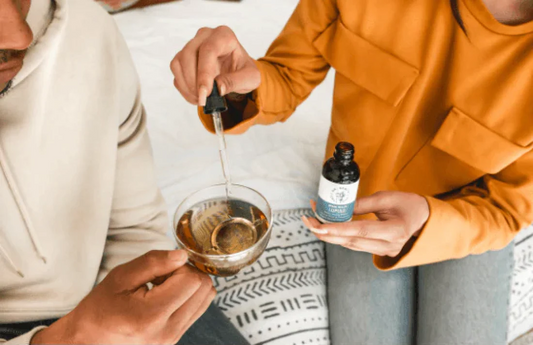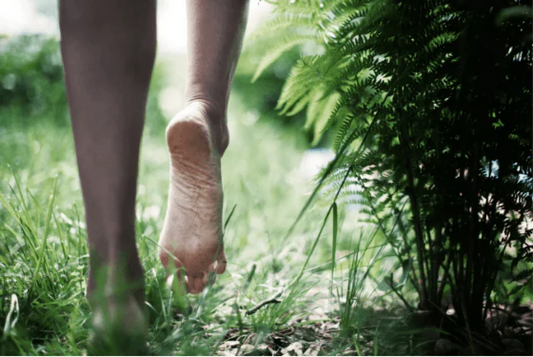Are the winter blues getting you down? Seasonal Affective Disorder (SAD) interferes with the happiness and wellbeing of nearly 10% of the US population. But, even if you’re not afflicted by SAD, this time of year can still mess with your mood.
This short SAD guide will help you identify practical ways to restore control of your emotions, and elevate your state of mind, so you can get through the seasonal sadness with a smile.
The newly launched Hemp & Chamomile Tea is ideal for soothing the symptoms of SAD (including depression, anxiety and insomnia) by reducing brain inflammation and calming the nervous system. Think of it like a warm hug, in a mug!
“Make one healthy choice every day.” - Dr. Sebi
What is Seasonal Affective Disorder?
Seasonal Affective Disorder (appropriately shortened to SAD) is a kind of depression that mostly occurs during the fall and winter, when there is less daylight because the days are shorter. SAD mostly affects adults over the age of 20 and women are more impacted than men.
From an evolutionary perspective winter is a time to rest and ‘hibernate’ to survive until Spring (using-up the stock piled calories put on as fat). Sadly our modern experience of this ‘slow’ season has changed completely; with winter becoming a frantic commercial opportunity.
There are at least three big winter events (Thanksgiving, Christmas and New Year’s Eve) that transform the season into a joyful time of celebration. But, they can also cause financial stress, family arguments, food excess and alcoholic binges – adding to the SADness of the season. For many people these celebrations are incredibly stressful and can trigger feelings of loneliness and despair.
Seasonal Hormonal Shift
Three critical hormones directly impact your brain and cause SAD symptoms:
Melatonin - The darker days and longer nights increase the production of the sleep inducing hormone melatonin. The hormone is also responsible for reproductive and behavioral changes (including reduced libido) that evolved to conserve energy during times when less food was naturally available.
Cortisol – The increase in melatonin is coupled with a decrease in cortisol. Usually cortisol gets you going in the morning and directs the production of energy for daily activities. The seasonal drop in cortisol leads to fatigue and low mood, and people often seek out stimulants (like sugar and coffee) to provide artificial energy which makes the problem worse.
Serotonin – Reduced levels of sunlight (duration, frequency and strength) impairs conversion of the happiness hormone, serotonin, to its active form (a reaction which takes place just beneath the skin’s surface). Serotonin is responsible for promoting happiness, while keeping our mood and emotions stable. The body also uses serotonin in regulating sleep and digestion.
The triple-hormone imbalance creates a vicious cycle, making it hard to restore a positive mood and regain lost energy. Essentially the body would like to slow down and maybe even hibernate. Add to this some stress inducing parties plus seasonal sales, and it’s no wonder we find this time of year so difficult.
Symptoms of SAD
People who are impacted by SAD will show some or many of the following symptoms due to the hormonal shifts and reduced energy levels:
- Anxiety
- Difficulty thinking clearly
- Fatigue
- Feeling sleepy in the daytime
- Feeling despair (a loss of hope) and guilt
- Inability to focus
- Increased appetite
- Insomnia
- Irritability
- Isolating yourself from social events
- Losing interest in activities usually enjoyed
- Low sex drive
- Needing to sleep more
- Physical problems, such as headaches
- Weight gain
All of these symptoms are the result of natural hormonal shifts that evolved to help us get through winter. The problem is that our modern celebration season bears no resemblance to the winter’s our ancestors endured; food excess and artificial lights play havoc with winter hormones.
Reducing SAD Symptoms
You can reduce the symptoms of SAD by increasing the energy in your body and sending the right signals to your subconscious:
- Energized Food - Following Dr. Sebi’s Nutritional Guide, full of nourishing alkaline bioelectric foods, will help your body feel like it is Spring (pumping you full of energy and vitality). Cutting out inflammatory processed foods also ensures your body can dedicate maximum energy to rejuvenation, and not waste effort dealing with toxins and mucus.
- Physical Activity - it makes you feel good and has an abundance of health benefits, including increasing the brain’s production of serotonin, and reducing the symptoms of depression. Movement activates the production of energy in your mitochondria and helps you sleep at night.
- Light Therapy – This is one of the most common solutions to SAD. Special lamps called light boxes (costing between $25 and $40) mimic sunlight with light up to 20 times brighter than a normal lamp. This helps activate serotonin and reduce melatonin.
- Natural Light – Getting outside in the sunlight will naturally rebalance hormones, especially if you can get some peak sun during the middle of the day. Watching the sun rise and set can also help get you back into a regular rhythm if sleep is a problem. Lack of sun is the instigator of the hormonal shift, meaning sun can also provide the solution.
- Professional Guidance - seeking professional support may be required. Cognitive behavioral therapy (CBT) is known to reduce the symptoms of SAD and give you a greater sense of control. This type of therapy gives you tools to actively change your mind and mood when feeling sad or under stress.
- Regular Schedule - Your body is constantly trying to predict your energy needs, and it becomes much more efficient when you wake, eat and sleep at regular times. Planning your meal times, and sticking to them, can dramatically improve your circadian rhythm which dictates patterns of hormones and energy production throughout the day.
- Social Connections - Social connections and a strong support network reduce the severity of depression and can ease anxious thinking. Having someone to talk to about your problems can help you process what you’re going through.
Beating the Blues
Cannabidiol (CBD) is well-known for its antidepressant effects. Various studies have demonstrated CBD’s ability to relieve anxiety and depression. While CBD doesn’t get you the extra sunlight your body craves, it does help balance out the hormonal shifts, and restore a more positive mental landscape.
CBD interacts with the body’s natural mood-regulation (endocannabinoid) system – boosting the brain’s production of the feel-good neurotransmitters serotonin and dopamine, which play a vital role in regulating happiness. CBD also relieves the most intrusive SAD symptoms, including insomnia, increased appetite and social anxiety.
Full-Spectrum Hemp-CBD upgrades your mood and mental state with natural antidepressant power. Enjoy increased feelings of wellbeing - elevating your mind, mood, and mojo, without messing with your mental clarity. Don’t be SAD this winter, enhance your day with Dr. Sebi’s Cell Food brand new Full Spectrum Hemp & Chamomile Tea.
Chamomile soothes your central nervous system, reduces inflammation and helps you get a deep, peaceful sleep, allowing you to wake up refreshed and prepared to deal with the challenges of the day, whether they come from within your mind or the madness of the world outside. You can now sip your way to a brighter day with our new tasty tea that combines calming chamomile with the natural caretaker CBD.
Winter is traditionally a time of rest and reflection. Ensure you take time out to be still, get some sun (even if it is just for a few minutes) and ensure you are looking after your body during this time of stress and excess. After the winter solstice, the days are getting longer, but with some herbal help, you can beat the winter blues and take control of your mood.


















































